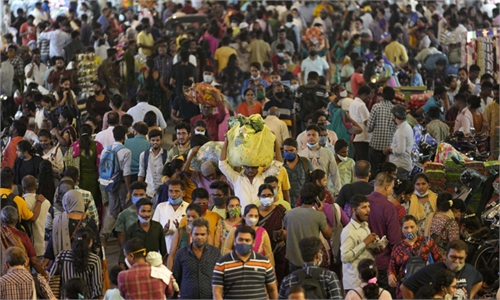
Illustration: Chen Xia/GT
India is set to overtake China as the world's most populous nation, according to United Nations data released on April 19. The UN Population Fund's "State of World Population Report" for 2023 estimates India's population will be 1.4286 billion by the middle of 2023 - ahead of the 1.4257 billion it sees for China's population. Moreover, India's population will continue to grow, while China witnessed its first population decline in 2022. Therefore, India is projected to remain the world's most populous country for a considerable period of time in the future.Large scale of the population is a significant driver of economic development in a country with relatively backward economy and technology. A considerable population size allows for the development of a wide range of industries, and abundant and low-cost labor force is the prerequisite for a large number of foreign companies to set up factories in India in recent years. A colossal population also means a huge market, which not only attracts foreign investment, but also serves as a lever for diplomacy. At the same time, even if India's overall education and technology level lags behind, it is possible to cultivate great talent and concentrate certain resources with a large population base.
Not only will India have a larger population than China, but more than half of the population is under the age of 30, which has the potential to produce a demographic dividend in the longer term. Some believe that India will have promising economic prospects, and will probably surpass China as the new world factory. But it is worth noting that India has not generated a demographic dividend with its enormous population since its independence in 1947. There are various long-standing problems that India must solve to convert its population into a demographic dividend.
First, the Indian government lacks efficiency, and partisan struggles have stalled land acquisition reform, labor law reform and tax reform on which Indian society has reached a consensus over for a long time. Moreover, the Indian government has set up plenty of lengthy permit approvals for business investment, production and operation.
Second, India's infrastructure still relatively lags behind other major and emerging economies.
Third, India's illiteracy rate of more than 20 percent has led to a shortage of qualified workers and technical personnel, let alone the loss of a large number of well-educated people flowing to Europe and the US.
Also, India is not highly open in its economic policies. A "tax check" is a usual means for the Indian government to snag foreign enterprises, making foreign companies cautious to invest in heavy assets in India.
India adds about 10 million new jobs every year. This generation grew up with smartphones and has learned about the wonderful world via the internet. They will not be staying in their comfort zone unlike those who grew up in isolated rural areas. If there are not enough job opportunities, a large number of idle young people may become a threat to social stability in India. India, with its population at its young stage, will enter the aging stage in 20 or 30 years. India needs to speed up reforms, attract international industrial transfer to a great extent, and maintain relatively high economic growth in order to accumulate more wealth.
For the past seven decades, China has been the most populous country in the world. China's population development model has gradually transitioned from a quantitative "demographic dividend" to a qualitative "talent dividend." From "demographic burden" to "demographic dividend," China has a lot of experience to offer India. For example, due to a lack of education, Indian workers are slow to master skills, resulting in low efficiency. The Indian government can improve their education level by strengthening basic education and developing vocational and technical education. In addition, the proportion of women participating in the labor force in India is relatively low, while one of China's advantages is that most women participate in the labor force, and the proportion of the labor force in the entire population is relatively high. India can provide more impetus for economic development by improving the status of women and developing women's education.
In fact, there is no point for either China or India to compete over population rankings. More attention should be paid to whether population is more beneficial to the economic and social development of the country and the world. China and India should make good use of their respective demographic dividends to achieve development and revitalization, and make greater contributions to the future of mankind.
Long Xingchun is a professor at the School of International Relations at Sichuan International Studies University. Lü Jiaying is a junior student at this university. opinion@globaltimes.com.cn



